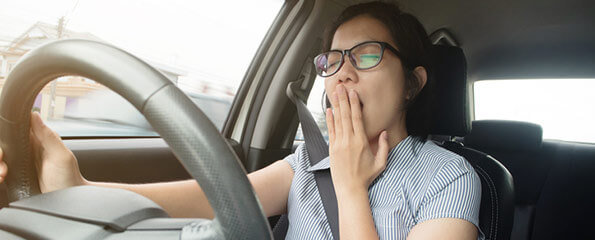Eye tracking might help reduce driver drowsiness
A revolutionary new way of detecting driver drowsiness by tracking eye movement could help reduce the road toll, a world-first study has found.
Using an eye-tracking system, researchers from Swinburne and Austin Health demonstrated that our visual attention – our ability to strategically scan the environment to avoid hazards – severely deteriorates when we are sleep deprived.
Drowsiness is a direct cause of 20 to 30 per cent of motor vehicle accidents in Australia.
“Although gains have been made in areas of road safety such as drink driving and speeding, it hasn’t been until recently that developing technologies can allow us to identify the altered ocular activity associated with drowsiness as a cause of accidents,” says Associate Professor Luke Downey, lead Swinburne researcher from the Centre for Human Psychopharmacology.
Impacting road safety
Associate Professor Mark Howard of Austin Health’s Institute of Breathing and Sleep Institute and Principal Investigator of the study published in Scientific Reports says the findings will impact road safety.
“Not only can we use these measures to monitor and evaluate drowsiness but they can then be used for potentially alerting the driver to impairment in real time or to a centralised base (eg truck company monitoring base).
“The measures could also be used to evaluate the impact of legislative changes on driver drowsiness and used by transport companies to assess whether particular schedules are dangerous.
“Australian companies are international leaders in alertness monitoring and very well placed to develop these findings for use in industry,” he says.
Collaborative trial
The trial was a collaboration between Austin Health and Swinburne’s Centre for Human Psychopharmacology.
Trial participants were kept awake for 36 hours before undertaking two hours of driving a car on a driving track. During the drive, their visual attention was assessed using an eye-tracking system. Driving impairment was evaluated by when the driver drifted out of their lane.
The study found that sleep deprivation affects control of eye movements, leading to less structured visual scanning, which increased the number of times drivers deviated from the centre of the lane.
Key findings were that after being sleep deprived, drivers were three times more likely to drive out of their lane, the frequency and duration of their eye blinks increased (so eyes remained closed for longer) and there was a reduced rate of visual fixation on other objects.
“Normally during driving, we would be looking at hazards on the side of the road and hazards ahead in traffic but sleep deprivation impairs our ability to do this. Part of the reason for this is that your gaze becomes more random than planned and part of it is to do with eye closure,” Associate Professor Howard says.
(Source: Swinburne University of Technology)
Dates
Tags
Created by:

 Login
Login














